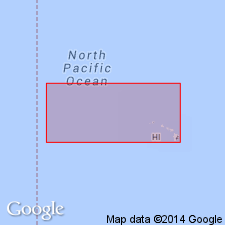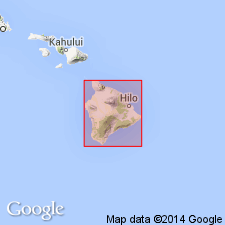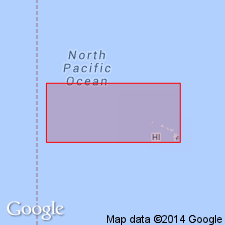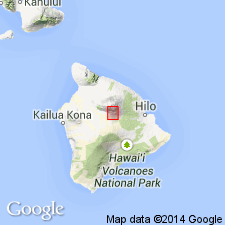
- Usage in publication:
-
- Waiau formation
- Modifications:
-
- Named
- Dominant lithology:
-
- Pyroclastics
- AAPG geologic province:
-
- Hawaii
Summary:
Named for Lake Waiau at summit of Mauna Kea Volcano, Island of Hawaii. Consists of central cinder cone phase and of yellow tuff phase of pyroclastic material produced from vents. "The Pahala tuff component of the Pahala formation, the Glenwood tuff, and the Kapukapu tuff are correlated with it but these names have priority for local use and it appears best at present to treat them as distinct units." Cinder cone phase extends possibly 1700 sq mi to average depth of not over 5 to 10 ft. Yellow tuff phase covers lower slopes. Consists of rather distinct bands of 1 to 6 inches in thickness. Waiau and Pahala tuffs appear to be essentially same age [Pleistocene(?)].
Source: GNU records (USGS DDS-6; Menlo GNULEX).

- Usage in publication:
-
- Waiau formation
- Modifications:
-
- Not used
- AAPG geologic province:
-
- Hawaii
Summary:
Waiau tuff [phase] of Wentworth (1938) now included in Pahala ash.
Source: GNU records (USGS DDS-6; Menlo GNULEX).

- Usage in publication:
-
- Waiau formation
- Modifications:
-
- Not used
- AAPG geologic province:
-
- Hawaii
Summary:
Consists of 2 principal phases: cinder cone surrounding vents and fresh ash deposits mantling large areas; and yellow palagonitic tuff at greater distances from vents. Cinder cone and fresh ash phase now largely included in Laupahoehoe volcanic series and partly in Hamakua volcanic series. Yellow palagonitic tuff phase now part of Pahala ash. Assigned Pleistocene to Recent age.
Source: GNU records (USGS DDS-6; Menlo GNULEX).

- Usage in publication:
-
- Waiau Formation†
- Modifications:
-
- Abandoned
- AAPG geologic province:
-
- Hawaii
Summary:
"The term, 'Waiau Formation' has been abandoned, for Mauna Kea tephra is demonstrably wide-ranging in age, was derived from a variety of source vents, and constitutes a complex succession of stratigraphic units of subformational rank, rather than being a single mappable deposit." "The local tephra layers...all belong to the Laupahoehoe Group."
Source: GNU records (USGS DDS-6; Menlo GNULEX).
For more information, please contact Nancy Stamm, Geologic Names Committee Secretary.
Asterisk (*) indicates published by U.S. Geological Survey authors.
"No current usage" (†) implies that a name has been abandoned or has fallen into disuse. Former usage and, if known, replacement name given in parentheses ( ).
Slash (/) indicates name conflicts with nomenclatural guidelines (CSN, 1933; ACSN, 1961, 1970; NACSN, 1983, 2005, 2021). May be explained within brackets ([ ]).

